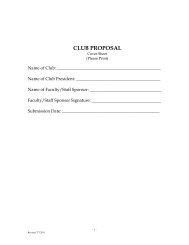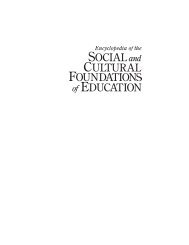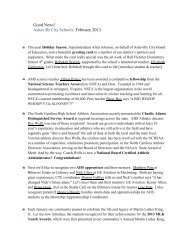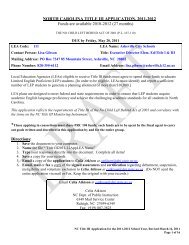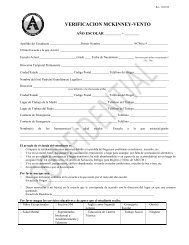Self-Assessment Disproportionate Representation - Asheville City ...
Self-Assessment Disproportionate Representation - Asheville City ...
Self-Assessment Disproportionate Representation - Asheville City ...
You also want an ePaper? Increase the reach of your titles
YUMPU automatically turns print PDFs into web optimized ePapers that Google loves.
SELF-ASSESSMENT FOR DISPROPORTIONATE REPRESENTATION:<br />
A REVIEW OF POLICIES, PRACTICES AND PROCEDURES<br />
Increasing effective educational programs for all students in all classes will reduce the number of<br />
inappropriate evaluations, placements and/or suspensions that contribute to disproportionate<br />
representation. This document has been developed to assist school districts in determining<br />
factors including policies, practices and procedures that could be contributing to disproportionate<br />
representation in the area of special education identification. This information will guide school<br />
districts in determining efficient action steps that can be taken in order to address<br />
disproportionate representation.<br />
Directions:<br />
Each school district must identify a team of professionals who will work together to review<br />
policies, practices and procedures that impact the issue of disproportionate representation. The<br />
team should include regular and special educators representing administration, professional<br />
learning, curriculum and instruction, school psychology, student support services, school<br />
improvement, and parents. Once the team is identified, they should meet to complete the selfassessment.<br />
Information from all schools in the district (preschool programs, elementary, middle<br />
and high schools and alternative programs) should be considered when completing the form. For<br />
those items that are rated as “Evidence”, please cite documentation to support this rating. The<br />
self-assessment should be mailed to the Exceptional Children Division no later than December<br />
19, 2007. Mail to Diann Irwin, Department of Public Instruction, 6356 Mail Service Center,<br />
Raleigh, NC 27699-6356.<br />
This document is adapted from documents developed by the Georgia Department of Education,<br />
National Center for Culturally Responsive Educational Systems and The Equity Center
System: <strong>Asheville</strong> <strong>City</strong> Schools<br />
Contact Person: (Superintendent’s Designee) Paul Perrotta<br />
E-mail Address: paul.perrotta@asheville.k12.nc.us<br />
Phone Number: 828-350-6128<br />
Team Members Who Participated in the <strong>Self</strong>-<strong>Assessment</strong>:<br />
Name<br />
Tanya Presha<br />
Kelly Lindsey<br />
Darrel Herndon<br />
Debra Prenata<br />
Josh Kumm<br />
Renoo Samms<br />
DeeDee Allen<br />
Charlotte Moore<br />
Christy Hicks<br />
Chris Cicotello<br />
Nancy Costello<br />
Stephnanie Keeber<br />
Pam Cocke<br />
Ann Ward<br />
Mary Schillereth<br />
Kyley Ferris<br />
Randall Johnson<br />
Lars Johnson<br />
Latessa Johnson<br />
Amy Cornett<br />
Joab Gouveia<br />
Laurie Mcdanel<br />
Title<br />
School Success Coordinator<br />
School Psychologist<br />
Assistant Principals, Jones<br />
Director of ACS Preschool<br />
EC Teacher, AHS<br />
School Counselor, Hall Fletcher<br />
School Counselor, Claxton<br />
Assistant Principal, Claxton<br />
EC Teacher, AMS<br />
SLP, Jones<br />
Literacy Coach, Elementary-level<br />
CTE Teacher, AHS<br />
Principal, AMS<br />
Executive Director of Curriculum and Instruction<br />
AIG Coordinator<br />
Kindergarten Teacher, Hall Fletcher<br />
EC Teacher, RLC<br />
PBS Coordinator<br />
Director of Student Services<br />
Program Support Specialist<br />
Lead School Psychologist<br />
Program Support Specialist<br />
Statement of Assurance<br />
Superintendent’s Signature: ________________________________________________________________<br />
2
<strong>Self</strong>-<strong>Assessment</strong> for <strong>Disproportionate</strong> <strong>Representation</strong><br />
Indicators of Policy, Procedures<br />
&<br />
Evidence Based<br />
Practices/Programs<br />
1. A universal screening ( ex.<br />
Dibels, K-2 <strong>Assessment</strong>s,<br />
Benchmarks) system is in place to<br />
assess strengths and challenges of<br />
all students in academic<br />
achievement, talents, behavior, and<br />
other areas that impact student<br />
performance.<br />
2. Schools use direct<br />
measurements of achievement and<br />
behavior to identify and rectify<br />
achievement discrepancies to<br />
improve positive student<br />
outcomes.<br />
3. High quality, systematic<br />
instruction is provided to students<br />
with deficits in precursor skills.<br />
4. There is shared responsibility<br />
among general educators and<br />
specific program area specialists<br />
(e.g. special education, ELL, AIG,<br />
Title I, curriculum specialist) for<br />
prevention and intervention.<br />
5. Prescriptive<br />
assessment/progress monitoring is<br />
used to promote effective<br />
instruction.<br />
6. Multiple sources of data are<br />
objectively analyzed by student<br />
support teams (SST) in order to<br />
determine the causes of a student’s<br />
difficulty prior to referring the<br />
student for evaluation.<br />
Not Addressed Beginning Developing Evidence<br />
Minimal<br />
implementation<br />
with 0 to 20% of<br />
schools<br />
implementing this<br />
practice.<br />
Emerging<br />
implementation<br />
with between 21%<br />
and 49% of schools<br />
implementing<br />
consistently and<br />
effectively.<br />
X<br />
X<br />
X<br />
X<br />
X<br />
Consistent<br />
implementation<br />
with between 50 to<br />
79% of school<br />
implementing<br />
effectively.<br />
X<br />
Widespread<br />
implementation in 80%<br />
or more of all schools<br />
with effective results.<br />
For each item rated as<br />
“Evidence”, cite<br />
supporting<br />
documentation.<br />
3
Indicators of Policy, Procedures<br />
&<br />
Evidence Based<br />
Practices/Programs<br />
7. Research-based reading instruction<br />
is provided. Please list program(s):<br />
Not<br />
Addressed<br />
Minimal<br />
implementation<br />
with 0 to 20% of<br />
schools<br />
implementing this<br />
practice.<br />
Beginning Developing Evidence<br />
Emerging<br />
implementation<br />
with between 21%<br />
and 49% of schools<br />
implementing<br />
consistently and<br />
effectively.<br />
Consistent<br />
implementation<br />
with between 50 to<br />
79% of school<br />
implementing<br />
effectively.<br />
Widespread<br />
implementation in 80%<br />
or more of all schools<br />
with effective results.<br />
For each item rated as<br />
“Evidence”, cite<br />
supporting<br />
documentation.<br />
- ACS Balanced English<br />
Language Arts Program<br />
- READ 180 (MS, HS, Alternative<br />
School)<br />
- Reading Recovery<br />
- SRA<br />
- Corrective Reading, SWD 3-5<br />
- Reading Mastery, SWD K-2<br />
8. Research-based mathematics<br />
instruction is provided. Please list<br />
program(s):<br />
- Scott Foresman Mathematics<br />
Program<br />
- Spiral Curriculum<br />
9. Other Research-based<br />
interventions or curricula are<br />
offered. Please list:<br />
- IMPACT<br />
- Positive Behavior Support<br />
- Second Step<br />
- Heartwood<br />
- Crisis Prevention Institute (CPI)<br />
- Padeia<br />
- Ustars<br />
- Comer<br />
- Implementation of the Problem<br />
Solving Model (PSM) with the<br />
Student Success Team Model<br />
(SST) and Response to<br />
Intervention (RtI)<br />
X<br />
X<br />
X<br />
(for evidence, see<br />
left hand column)<br />
4
Indicators of Policy, Procedures &<br />
Evidence Based Practices/Programs<br />
Not<br />
Addressed<br />
Beginning Developing Evidence<br />
Minimal<br />
implementatio<br />
n with 0 to<br />
20% of<br />
schools<br />
implementing<br />
this practice.<br />
Emerging<br />
implementation with<br />
between 21% and<br />
49% of schools<br />
implementing<br />
consistently and<br />
effectively.<br />
Consistent<br />
implementation with<br />
between 50 to 79% of<br />
school implementing<br />
effectively.<br />
Widespread<br />
implementation in 80% or<br />
more of all schools with<br />
effective results. For each<br />
item rated as “Evidence”,<br />
cite supporting<br />
documentation.<br />
10. Scientifically-based educational and<br />
behavioral interventions (FBA/BIP)<br />
recommended by the SST are tailored<br />
for the individual student, culturally<br />
appropriate, and effectively<br />
implemented in the classroom.<br />
11. The SST routinely reviews data that<br />
reflects the student’s progress after the<br />
plans have been implemented.<br />
Adjustments are made as needed and<br />
referral is made when necessary.<br />
12. Eligibility determination includes<br />
comprehensive data from a variety of<br />
sources and consideration of factors<br />
such as opportunity to learn, limited<br />
English proficiency, appropriate<br />
instruction in reading and math, and<br />
quality of instruction in language<br />
acquisition and/or appropriate behavior.<br />
13. Parents are involved in eligibility<br />
determination decisions as evidenced by<br />
prior notice/invitation to conference.<br />
EVIDENCE: File Audits, signed<br />
paperwork with parent signature and/or<br />
multiple attempts to invite, CIPP data<br />
14. The district procedures for location,<br />
referral and identification are<br />
transparent, equitable, and<br />
multidisciplinary and applied in<br />
accordance with federal and state<br />
regulations.<br />
EVIDENCE: Child Find activities,<br />
District procedures/manuals, ongoing<br />
staff training, DPI CIMS/CIPP audit,<br />
PSM/SST/RtI Training and<br />
implementation, collaboration with Part<br />
“C” agencies<br />
X<br />
X<br />
X<br />
X<br />
(for evidence, see<br />
left hand column)<br />
X<br />
(for evidence, see<br />
left hand column)<br />
X<br />
(for evidence, see<br />
left hand column)<br />
5
Indicators of Policy, Procedures &<br />
Evidence Based Practices/Programs<br />
15. The district annually reviews<br />
referral and eligibility decisions for<br />
special education including methods,<br />
types of measures and frequency with<br />
which identification decisions are<br />
made by race/ethnicity and gender.<br />
EVIDENCE: Ongoing audits,<br />
referral/eligibility data review<br />
sessions, case reviews with school<br />
psychologist groups<br />
16. Teachers and staff have been<br />
provided training in and consistently<br />
practice School-wide Positive<br />
Behavior Support.<br />
17. The school system has a plan in<br />
place that demonstrates rigorous<br />
efforts to recruit and retain minority<br />
teachers.<br />
EVIDENCE: ACS Human Resources<br />
has implemented a plan and<br />
recruitment team to for<br />
recruiting/retaining minority teachers.<br />
18. Principals and building leadership<br />
teams have had data analysis training<br />
and they apply knowledge gained to<br />
make effective improvements in<br />
learning environments and processes.<br />
19. Professional development about<br />
cultural language and ethnic diversity<br />
is provided to both regular and special<br />
education teachers across disciplines<br />
to facilitate effective development and<br />
implementation of early intervening<br />
services.<br />
Not<br />
Addressed<br />
Minimal<br />
implementation<br />
with 0to 20% of<br />
schools<br />
implementing<br />
this practice.<br />
Beginning Developing Evidence<br />
Emerging<br />
implementation with<br />
between 21% and<br />
49% of schools<br />
implementing<br />
consistently and<br />
effectively.<br />
X<br />
X<br />
Consistent<br />
implementatio<br />
n with between<br />
50 and 79% of<br />
schools<br />
implementing<br />
effectively.<br />
X<br />
Widespread<br />
implementation in 80%<br />
or more of all schools<br />
with effective results.<br />
For each item rated as<br />
“Evidence”, cite<br />
supporting<br />
documentation.<br />
X<br />
(for evidence, see<br />
left hand column)<br />
X<br />
6
Indicators of Policy, Procedures &<br />
Evidence Based<br />
Practices/Programs<br />
20. On-going supervision is<br />
provided in order to ensure that<br />
teachers struggling with classroom<br />
management receive assistance.<br />
21. Collaborative practices between<br />
general educators and exceptional<br />
children educators at both the<br />
prevention and intervention levels<br />
exists throughout the district.<br />
22. On-going training and support is<br />
provided to ensure that teachers<br />
address individual learning needs<br />
through differentiated instruction<br />
aligned to academic grade-level<br />
content.<br />
23. Limited English proficient<br />
students are afforded an equal<br />
education as evidenced by qualified<br />
teachers, adequate provision of<br />
English as a second language<br />
services, successful mainstreaming,<br />
and satisfactory school achievement.<br />
24. The district ensures that students<br />
who are culturally and linguistically<br />
diverse are represented equitably in<br />
all programs, including those for<br />
gifted and rapidly progressing<br />
students.<br />
25. The district has a policy that<br />
ensures that monetary, physical, and<br />
other resources, including qualified<br />
personnel, are distributed to schools<br />
according to need.<br />
Not<br />
Addressed<br />
Minimal<br />
implementation<br />
with 0 to 20%<br />
of schools<br />
implementing<br />
this practice.<br />
Beginning Developing Evidence<br />
Emerging<br />
implementation<br />
with between 21%<br />
and 49%<br />
of schools<br />
implementing<br />
consistently and<br />
effectively.<br />
X<br />
X<br />
X<br />
X<br />
X<br />
X<br />
Consistent<br />
implementation<br />
with between 50<br />
and 79% of<br />
schools<br />
implementing<br />
effectively.<br />
Widespread<br />
implementation in 80%<br />
or more of all schools<br />
with effective results.<br />
For each item rated as<br />
“Evidence”, cite<br />
supporting<br />
documentation.<br />
7
Summary:<br />
After the review of your policy, procedures and practices above, please state the hypotheses for<br />
your LEA’s disproportionate representation:<br />
<strong>Asheville</strong> <strong>City</strong> Schools had a 23 member, multidisciplinary team break up into three groups to<br />
review and analyze the Indicators of Policy, Procedures & Evidence Based Practices/Programs.<br />
Each group reviewed all 25 indicators by having a discussion, taking notes, identifying areas of<br />
concern/need and areas of strength. Each group shared their findings in a large group summary<br />
discussion.<br />
The factors below have been identified as “relative” to a hypothesis for disproportionate<br />
representation in <strong>Asheville</strong> <strong>City</strong> Schools:<br />
1. student equity and readiness issues<br />
2. a need to increase support and resources for teachers dealing with challenging behaviors<br />
3. more curriculum based assessments/measurements<br />
4. ongoing development of universal screenings<br />
5. further development of targeted research based interventions matching the needs of<br />
students at risk and/or suspected of having a disability<br />
6. socio-economic, mental health and environmental contributing factors<br />
7. ongoing training in the area of differentiated instruction<br />
8. more assurances with instruction being implemented with fidelity<br />
9. greater attention and priority to early intervention<br />
10. more continuous improvement efforts with the school based problem solving model and<br />
Positive Behavior Support (PBS) systems<br />
There was also reference and recommendation to combine a transition preschool focus team with<br />
the disproportionality team.<br />
8




